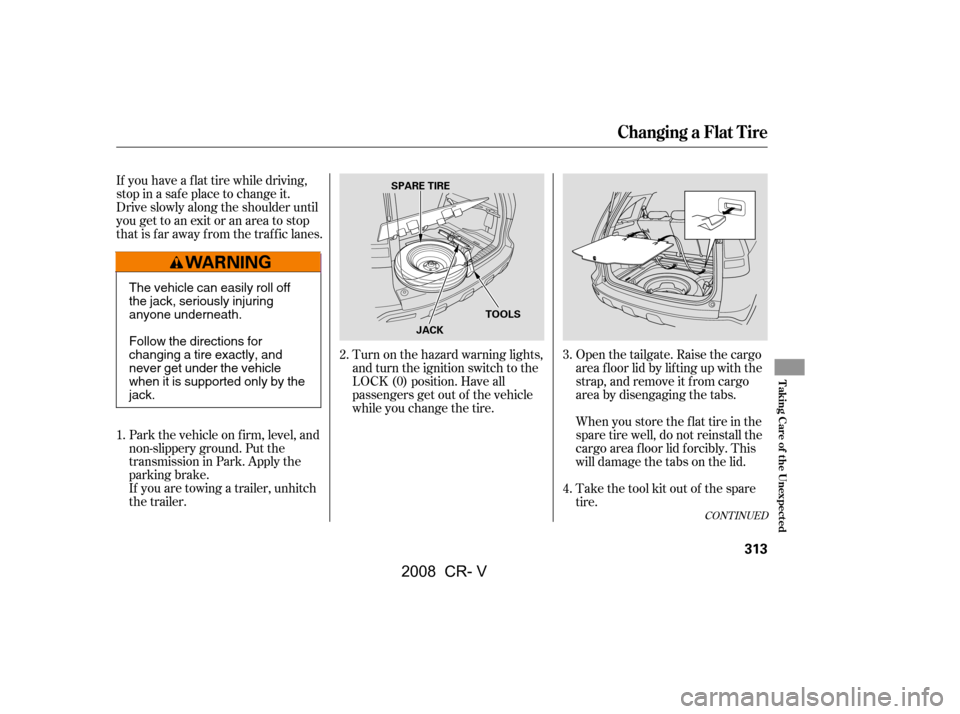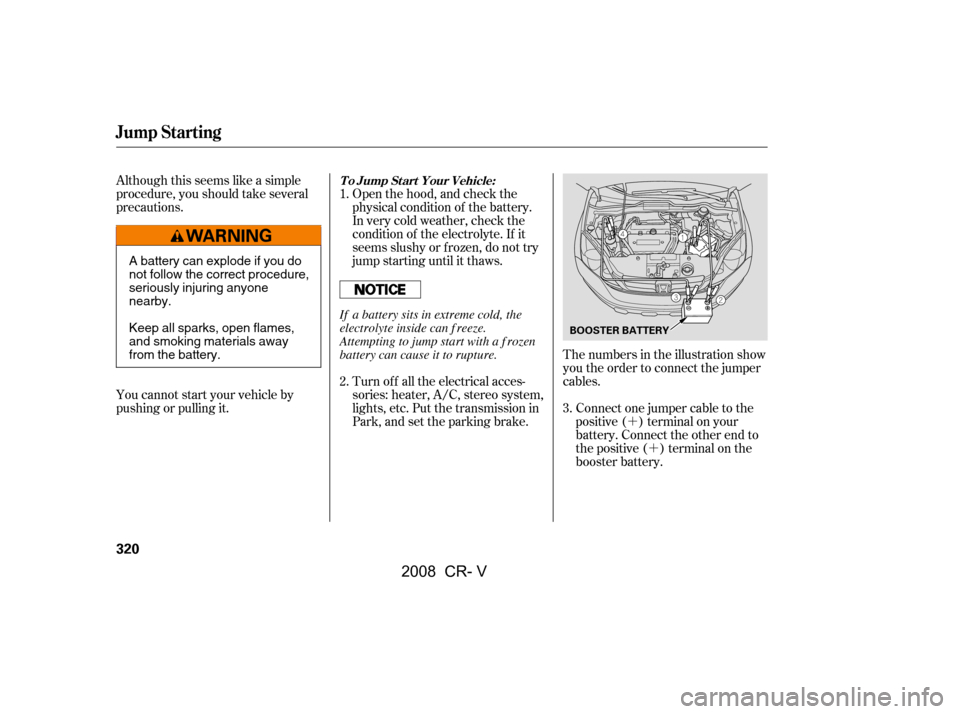Page 314 of 373

Fill the f uel tank.Block the rear wheels.
If the vehicle is to be stored f or a
longer period, it should be
supported on jackstands so the
tires are of f the ground.
Cover the vehicle with a
‘‘breathable’’ cover, one made
f rom a porous material such as
cotton. Non-porous materials, such
as plastic sheeting, trap moisture,
which can damage the paint.
If you need to park your vehicle f or
an extended period (more than 1
month), there are several things you
should do to prepare it f or storage.
Proper preparation helps prevent
deterioration and makes it easier to
get your vehicle back on the road. If
possible, store your vehicle indoors. Leave one window open slightly (if
the vehicle is being stored
indoors).
Disconnect the battery.
Support the f ront and rear wiper
blade arms with a f olded towel or
ragsotheydonottouchthe
windshield.
To minimize sticking, apply a
silicone spray lubricant to all door
and tailgate seals. Also, apply a
vehiclebodywaxtothepainted
surfaces that mate with the door
and tailgate seals.If possible, periodically run the
engine until it reaches f ull
operating temperature (the
cooling f ans cycle on and of f
twice). Pref erably, do this once a
month.
Wash and dry the exterior
completely.
Cleantheinterior.Makesurethe
carpeting, floor mats, etc., are
completely dry.
Leave the parking brake off. Put
the transmission in Park.
Vehicle Storage
310
�\f���—�\f���—�����y�
����
����
���y���
�(�,�����
�\f�y�\f���
���y
2008 CR- V
Page 315 of 373

This section covers the more
common problems that motorists
experience with their vehicles. It
gives you inf ormation about how to
safely evaluate the problem and what
to do to correct it. If the problem has
stranded you on the side of the road,
you may be able to get going again.
If not, you will also f ind instructions
on getting your vehicle towed.......................
Compact Spare Tire .312
....................
Changing a Flat Tire .313
.............
If the Engine Won’t Start .318
................................
Jump Starting .320
..............
If the Engine Overheats .322
.........
Low Oil Pressure Indicator .324
..........
Charging System Indicator .324
.......
Malf unction Indicator Lamp .325
...............
Brake System Indicator .326
..............................................
Fuses .327
..............................
Fuse Locations .330
......................
Emergency Towing .332
Taking Care of the Unexpected
T aking Care of t he Unexpect ed
311
�\f���—�\f���—�����y�
����
������
�y���
�(�,�����
�\f�y�\f���
���y
2008 CR- V
Page 317 of 373

If you have a f lat tire while driving,
stop in a saf e place to change it.
Drive slowly along the shoulder until
you get to an exit or an area to stop
that is far away from the traffic lanes.
Park the vehicle on f irm, level, and
non-slippery ground. Put the
transmission in Park. Apply the
parking brake.
If you are towing a trailer, unhitch
the trailer.
Turn on the hazard warning lights,
and turn the ignition switch to the
LOCK (0) position. Have all
passengers get out of the vehicle
while you change the tire.
Open the tailgate. Raise the cargo
area f loor lid by lif ting up with the
strap, and remove it f rom cargo
area by disengaging the tabs.
When you store the f lat tire in the
spare tire well, do not reinstall the
cargo area f loor lid f orcibly. This
will damage the tabs on the lid.
Take the tool kit out of the spare
tire.
1.
2. 3.
4.
CONT INUED
Changing a Flat Tire
T aking Care of t he Unexpect ed
313
JACK
SPARE TIRE
TOOLS
The vehicle can easily roll off
the jack, seriously injuring
anyone underneath.
Follow the directions for
changing a tire exactly, and
never get under the vehicle
when it is supported only by the
jack.
�����—�����—�����y�
����
��������y���
�(�,�����
���y�����
���y
2008 CR- V
Page 319 of 373
CONT INUED
Use the extension and the wheel
nut wrench as shown to raise the
vehicle until the f lat tire is of f the
ground.
Remove the wheel nuts, then
remove the f lat tire. Handle the
wheel nuts caref ully; they may be
hot from driving. Place the flat tire
on the ground with the outside
surface facing up.Bef ore mounting the spare tire,
wipeanydirtoff themounting
surface of the wheel and hub with
a clean cloth. Wipe the hub
carefully;itmaybehotfrom
driving.Put on the spare tire. Put the
wheel nuts back on f inger-tight,
then tighten them in a crisscross
pattern with the wheel nut wrench
until the wheel is f irmly against
the hub. Do not try to tighten the
wheel nuts f ully.
Lower the vehicle to the ground,
and remove the jack.
9.
10. 11.13.
12.
Changing a Flat Tire
T aking Care of t he Unexpect ed
315
EXTENSION
BRAKE HUB
WHEEL NUT WRENCH
�\f���—�\f���—�����y�
����
��������y���
�(�,�����
�\f�y�\f�����\f�y
2008 CR- V
Page 324 of 373

�´
�´
Although this seems like a simple
procedure, you should take several
precautions.
Open the hood, and check the
physical condition of the battery.
In very cold weather, check the
condition of the electrolyte. If it
seems slushy or f rozen, do not try
jump starting until it thaws.
Connect one jumper cable to the
positive ( ) terminal on your
battery. Connect the other end to
the positive ( ) terminal on the
booster battery.
The numbers in the illustration show
you the order to connect the jumper
cables.
You cannot start your vehicle by
pushing or pulling it.
Turn of f all the electrical acces-
sories: heater, A/C, stereo system,
lights, etc. Put the transmission in
Park, and set the parking brake.
1.
2.
3.
To Jump Start Your Vehicle:
Jump Starting
320
BOOSTER BATTERY
A battery can explode if you do
not follow the correct procedure,
seriously injuring anyone
nearby.
Keep all sparks, open flames,
and smoking materials away
from the battery.
If a battery sits in extreme cold, the
electrolyte inside can f reeze.
Attempting to jump start with a f rozen
battery can cause it to rupture.
�����—�����—�����y�
����
��������y���
�(�,�����
���y���������y
2008 CR- V
Page 326 of 373

If the vehicle overheats, you should
take immediate action. The only
indication may be the temperature
gauge climbing to or above the red
mark. Or you may see steam or
spray coming f rom under the hood.
The reading of the vehicle’s
temperature gauge should stay in
the midrange. If it climbs to the red
mark, you should determine the
reason (hot day, driving up a steep
hill, etc.).
Saf ely pull to the side of the road.
Put the transmission in Park, and
set the parking brake. Turn of f the
all accessories, and turn on the
hazard warning indicators.
If you do not see steam or spray,
leave the engine running, and
watch the temperature gauge. If
the high heat is due to overloading,
the engine should start to cool
down almost immediately. If it
does, wait until the temperature
gauge reading comes down to the
midpoint, then continue driving.
If the temperature gauge reading
stays at the red mark, turn off the
engine.
If you see steam and/or spray
coming f rom under the hood, turn
of f the engine. Wait until you see
no more signs of steam or spray,
then open the hood.
1.
2.
3.
4.
If theEngineOverheats
322
Steam and spray from an
overheated engine can
seriously scald you.
Do not open the hood if steam
is coming out.
Driving with the temperature gauge
reading at the red mark can cause
serious damage to the engine.
�����—�����—�����y�
����
��������y���
�(�,�����
���y���������y
2008 CR- V
Page 330 of 373

However, if the brake pedal does not
f eel normal, you should take
immediate action. A problem in one
part of the system’s dual circuit
design will still give you braking at
two wheels. You will f eel the brake
pedal go down much f arther bef ore
the vehicle begins to slow down, and
you will have to press harder on the
pedal.
If you must drive the vehicle a short
distance in this condition, drive
slowly and caref ully. Slow down by shif ting to a lower
gear, and pull to the side of the road
when it is saf e. Because of the long
distance needed to stop, it is
hazardous to drive the vehicle. You
should have it towed and repaired as
soon as possible (seeon page ). If the ABS indicator and the VSA
system indicator come on with the
brake system indicator, have your
vehicle inspected by your dealer
immediately.
The brake system indicator normally
comes on when you turn the ignition
switch to the ON (II) position, and as
a reminder to check the parking
brake. It will stay on if you do not
f ully release the parking brake.
If the brake system indicator comes
on while driving, the brake f luid level
is probably low. Press lightly on the
brake pedal to see if it f eels normal.
If it does, check the brake f luid level
thenexttimeyoustopataservice
station (see page ).
If the f luid level is low, take your
vehicle to a dealer, and have the
brake system inspected f or leaks or
worn brake pads. 289
332Emergency
Towing
Brake System Indicator
326
Canada
U.S.
�����—�����—�����y�
����
����
���y���
�(�,�����
���y�������
�y
2008 CR- V
Page 341 of 373

�µ
�µ�µ
�µ
�µ
�µ
�µ
�µ
�µ
�µ
�µ
�µ
�µ
�µ
�µ
�µ
�µ
Specif ications
Technical Inf ormation
337
Fuses
Alignment
Tires
Battery
Lights
Air Conditioning
Seating Capacities Interior
Under-hood
Toe-in
Camber
Caster0.0in(0mm)
0.08 in (2.0 mm) 0°
1°00’
1°45’
225/65R17 102T
Size
Pressure
30 psi (210 kPa , 2.1 kgf/cm
)
30 psi (210 kPa , 2.1 kgf/cm)
T155/90D17 101M
60 psi (420 kPa , 4.2 kgf/cm
)
Capacity 12 V
12 V47 AH/20 HR
36 AH/5 HR
12 V
12 V
12 V
12 V
12 V
12 V
12 V
12 V
12 V
12 V
12 V
12 V
21 W
5W
8W
8W
8W
5W
21 W
21/5 W
21 W
3CP
21 W
50/55 W
Headlights
Front turn signal lights
Parking lights/side marker
lights
Rear turn signal lights
Stop/Taillights
Back-up lights
License plate light
Ceiling light
Spotlights
Cargo area light
Rear side marker lights
High-mount brake light
Refrigerant type
Charge quantity
Lubricant type SP-10 15.5 17.3 oz (440 490 g)HFC-134a (R-134a) 5
2
3
See page330or the fuse label
attached under the steering
column.
See page331or the fuse box
cover.
Total
Front
Rear
Front
Rear
Front
Rear
Front
High/Low (HB2)
Front/Rear
Spare
Front
Rear
Spare
(Amber)
(Amber)
�\f���—�\f���—�����y�
����
�
����\f�y���
�(�,�����
�\f�y�\f�������y
2008 CR- V